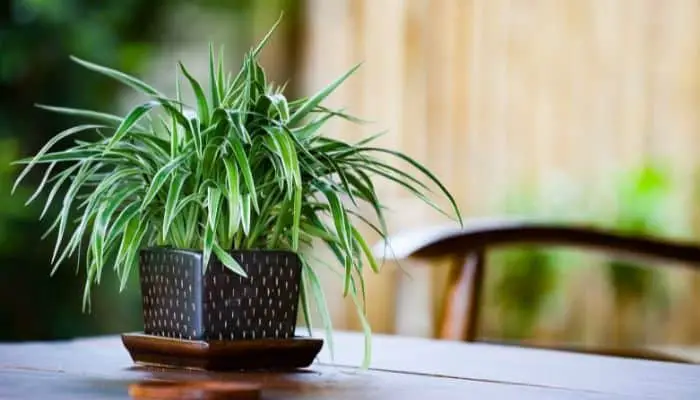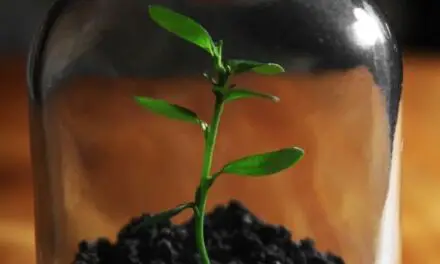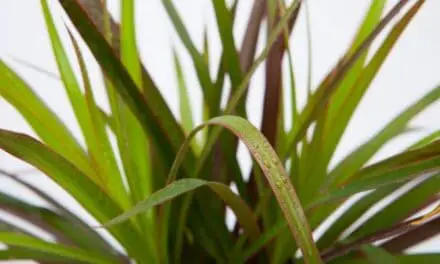If your spider plant looks like it’s pushing itself up out of the soil or if you notice roots growing out of the drainage holes, it’s probably time to think about repotting.
The days and weeks following repotting can be a worrying time and if things don’t go smoothly your plant can quickly take a turn for the worse.
Sometimes it’s not clear why your spider plant looks as though it is dying after you repot it, and it can be frustrating trying to figure out what has gone wrong.
Table of Contents
Why Is My Spider Plant Dying After Repotting?

Your spider plant is dying after repotting because either its root system has been damaged, it’s not receiving enough light, it is suffering from transplant shock, it has been overwatered after repotting or it has been replanted into a pot that is too big.
But the most likely reason for a spider plant to die after being repotted is due to root damage that occurred during the transfer.
The spider plant has large tuberous roots that store water and nutrients.
And if you damage or remove too many of these roots during repotting, your plant can struggle afterward.
Another possibility is that the new potting medium contains too much fertilizer.
Rich compost could cause wilting or unhappiness.
Alternatively, you may have watered it too heavily or put it in a spot that is too shady for its liking.
Root Damage
If you damage your spider plant’s roots when repotting it will direct most of its energy into repairing its root system.
This can leave your spider plant’s foliage looking as if it is dying.
There is always a risk of damaging a spider plant’s roots when you move it from one container into another – especially if it has seriously outgrown its original pot.
It can be difficult to untangle a mesh of roots, and you’ll often find that you end up breaking at least some as you fight it free of its container.
You may need to cut roots away to get it out, or you may find that you snap some while you are trying to settle it into the new soil.
If it is very root-bound and compacted, your spider plant might actually benefit from having some snapped so that you can encourage the main roots to spread out and take advantage of the new space.
After all, nobody is going to tell the spider plant it has a new pot, and it might not utilize this space immediately if you don’t redirect its root growth!
However, doing so is often stressful for the plant, and if you damage the roots significantly, the spider plant may look like it’s dying for a while.
It might even be dying if you have really damaged its roots.
Also Read: How To Make Your Spider Plant Bushier
Transplant Shock
Transplanting can also shock plants, so even if your spider plant’s roots aren’t damaged, the move can slow its growth and make it sick for a while.
You should treat your plant gently, watering it and keeping it in a cool space until it has settled into its new container.
If it doesn’t start to perk up after a week or two, it may be suffering from more than just transplant shock.
Too Much Fertilizer
Spider plants do not like huge amounts of nutrients in the soil and fertilizing after repotting can cause issues.
Over-fertilizing your spider plant is usually a result of a feeding routine that has got too zealous, but it is possible that if you plant your spider plant in very rich compost or manure, it will suffer as a result.
While spider plants do benefit from fertilization, they are one of the hardier plants that do not need a lot of it to grow well.
If you put too much fertilizer in their soil, you may notice that their leaf tips turn brown.
This is unlikely to kill it outright, but may make your spider plant look as though it is dying for a while after repotting.
Too Much Water
We always water plants when we move them to a new pot.
It helps the root hairs settle into the soil and keeps them cool, as well as ensuring that the plant has plenty to drink.
Potting soil tends to be dry when you fill the pot, so it is important to water it once the plant is in place.
However, if you water a spider plant too much, its roots will rot and it will die.
Poor Drainage
Often, if you have repotted a plant and forgotten to add good drainage, you might notice your spider plant is suffering from sitting in water.
This may be because it isn’t draining properly, rather than because you are giving it too much to drink.
The Pot Is Too Big
If you repotted your spider plant into a pot that is too big the soil will not dry out enough between watering times and your plant may eventually rot and die.
Only choose a new pot for your spider plant that is 1 or 2 inches bigger than the old pot.
Poor Soil
Make sure that you mix a good draining material, such as perlite, into compost when repotting a plant, and check it is drying out between waterings.
You should also make sure you are using rainwater rather than tap water, but this is unlikely to be a problem associated with repotting!
The Soil Has Not Been Pushed Down Around The Roots
Once you repot your spider plant and fill in soil around the sides of the pot, you’ll need to ensure that the soil has been pushed down around the root ball of your plant.
Once filled in, take a small stick and gently push down on the soil and work out any air pockets.
This will help the soil to surround the root ball and all of the roots will be better able to access water and nutrients from the soil around them.
Too Much Shade
If you are still having problems, look at whether you have repositioned your spider plant after repotting it.
It might be an unconscious move, or perhaps it doesn’t fit back in the old spot you had for it.
While spider plants don’t need much direct sunlight, they won’t thrive if they are placed in full shade.
Getting plants in the right places can be a challenge, especially if you are limited on space and have a lot of plants, but try and put your spider plant somewhere it can benefit from a good bit of indirect sunlight.
If your plant’s new pot doesn’t allow for this, consider whether you can move the spider plant to another room, or even think about whether you could hang its pot up somewhere to maximize the light.
Spider plants look beautiful dangling from ceilings, so this might be an option to lift them out of the shade.
Final Thoughts
Spider plants should rarely be so sick as to die when they have just been repotted but they may look as though they are dying for a while.
On the whole, they are hardy plants that seem impossible to kill (except perhaps by over-watering), so give your plant a bit of time to settle in, and consider these possible issues in the meantime.
As long as your plant has good soil, the right amount of light, and plenty of water, it should be fine in its new pot, even if the roots have taken a bit of damage during the transfer.
The plant will re-grow them, though it does take time!




